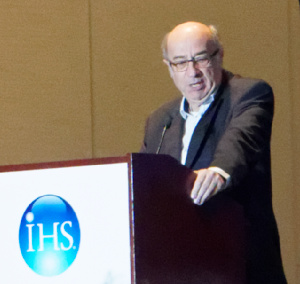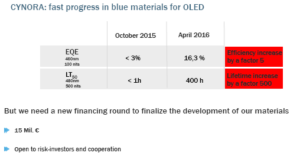 Gildas Sorin is from Cynora of Germany but he was a founder of Novaled which was sold to Samsung. He had gone into retirement, but decided to join Cynora because of the opportunity that it had. It is based in Bruchsal near Karlsruhe, Germany and it is working on TADF materials. The team includes the ex-CTO of Osram Opto.
Gildas Sorin is from Cynora of Germany but he was a founder of Novaled which was sold to Samsung. He had gone into retirement, but decided to join Cynora because of the opportunity that it had. It is based in Bruchsal near Karlsruhe, Germany and it is working on TADF materials. The team includes the ex-CTO of Osram Opto.
There are more than fifty staff in the team. Sorin is sure that the display business will move to AMOLED and he believes that Samsung will supply 100 million OLED panels by 2018. OLED is currently dominated by LG and Samsung but Chinese companies will enter the market and they are expected to want to dominate that market as they are about to do in LCD.
Power efficiency is a critical factor for OLEDs, but at the same time resolution has to be increased. Red and green materials have been available in phosphorescent mode, but deep blue is not available, partly because of lifetime issues. TADF is said to solve that
Cynora’s material can go up to 20% external quantum efficiency – from around 5% now. As a result this should mean a 2X reduction in power consumption for the device and increase the resolution, at the same time, Sorin said. (for more on the technology, see our previous article Copper Raises OLED Efficiency to 100%)
TADF is in the public domain, so there is no patent position, like phosphorescent materials controlled by UDC, Sorin said. The European patent office has taken a strong view on UDC’s patents. but Cynora has a big portfolio of more than 300 patent applications, with around 100 awarded and the total will grow.
Blue material has been the focus since October 2015, although the firm has been working on TADF materials for five years. Since October, it has got to 400h (from <1 hour in October to 400 hours now). The company has been working on deep blues, but light blue is being used for lifetime studies.
Soran showed a radar chart of the current fluorescent materials. There is still quite a long way to go with a big next step by September to boost the efficiency for the deep blue. The commercial target is to have material available by the end of the year for testing and hopes to have commercial products using Cynora material available during 2018, with a target of volume production shipments in 2019.
The firm is raising €15 million and the company has three current investors. (BR)

